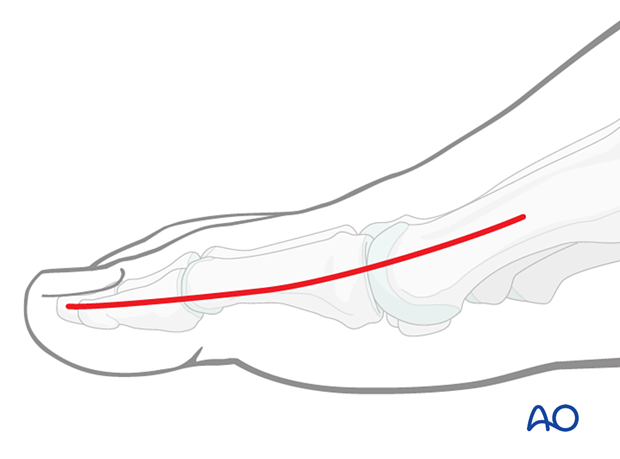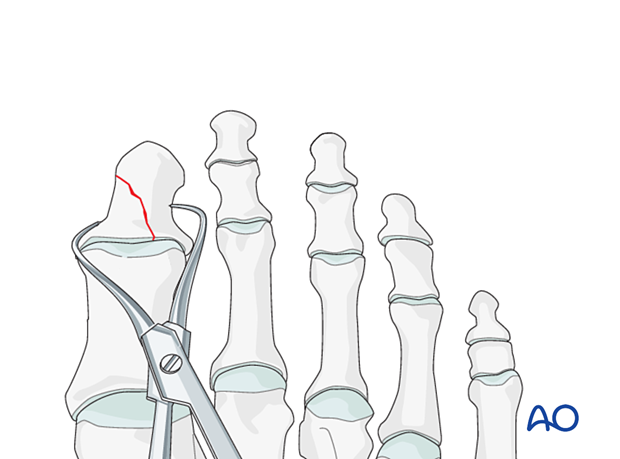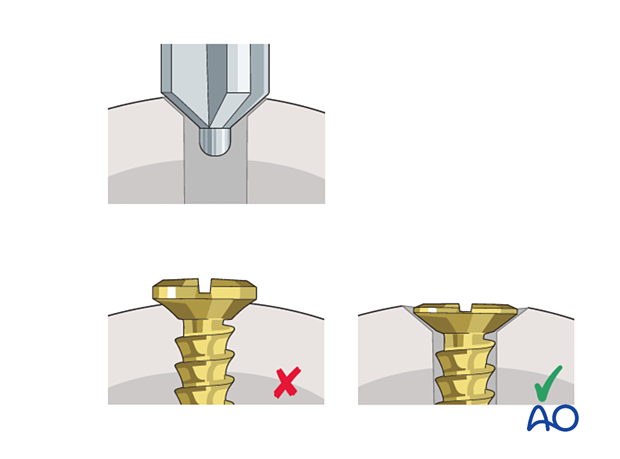Lag-screw fixation
1. Introduction
These fractures involve small segments, which typically only permit fixation with one lag screw.
Anatomical reduction of the joint surface is important to prevent chronic instability or posttraumatic degenerative joint disease.

Toe fractures versus long bone fractures
Toe fractures are different from long bone fractures.
- The bones are very small
- Fracture gaps are small
- Fixation devices don't need to counter large forces
Thus, following the AO principles is less critical than for long bones, and often isolated screws or K-wires alone will work satisfactorily.
Restoration of length, rotation, and angulation are important for cosmesis.
The hallux is particularly critical due to its importance for walking.
Timing of surgery
The timing of surgery is influenced by the soft tissue injury and the patient's physiologic status.
Dislocation or injuries associated with the skin at risk requires immediate intervention regardless of the amount of soft tissue swelling.
If possible, swelling should be significantly decreased before surgery, which can take up to two weeks in some instances.
Open fractures should be promptly irrigated and debrided, and treated with antibiotics. Definitive fracture fixation may not be possible during this setting.
Forefoot fractures do not contribute to physiologic instability. If there is no soft tissue at risk, urgent intervention is not required.
2. Patient preparation and approach
Patient preparation
This procedure is typically performed with the patient placed supine and the knee flexed 90°.

Approach
Intraarticular head fractures of the proximal phalanx of the hallux may be approached through either:

3. Reduction
Indirect reduction
Reduction starts with traction to restore length.
Lateral pressure exerted by the surgeon's thumb and index finger will reduce the fracture.
Confirm reduction using image intensification.

Direct reduction
VisualizationVisualization of the joint is challenging.
Visualization may be improved by longitudinal distraction or by using a percutaneous reduction aid such as a mini distractor.

Clean the fracture using a dental pick. Direct suction or irrigation is helpful.
The fracture edges are exposed, and the fragment mobility is assessed. It is essential to maintain the vascularity of small fragments.
The extent of articular involvement is assessed, including separate osteochondral fragments.

The fracture is reduced using one of the below techniques.
- A small pointed reduction forceps can be used to reduce larger fragments and temporarily secure the reduction. Be careful not to apply excessive force as this can lead to fragmentation.
- K-wires can be inserted into the fragment and used as a joystick. Once reduction is accomplished, the wire may be advanced to secure the reduction.
- A periosteal elevator can be used as a lever to reduce the fracture. Once reduction is achieved, it can be secured using reduction forceps or a K-wire.
If K-wires are used to secure the fixation, they should not interfere with the planned screw or plate placement.
Restore anatomical axial rotation, length, and angulation.
Confirm reduction using image intensification.

4. Lag screw fixation
Depending on the size of the fragment, a 2.0 mm or 2.4 mm bicortical lag screw is inserted.
Implants larger than 2.7 mm will frequently cause fragmentation.


5. Aftercare
Weight-bearing may be allowed as long as the patient is provided with a flat, rigid sole shoe, which is continued for 6–10 weeks until x-rays or clinical examination is consistent with healing.
Range of motion exercises (both actively and passively) may be initiated once soft tissues permit.














